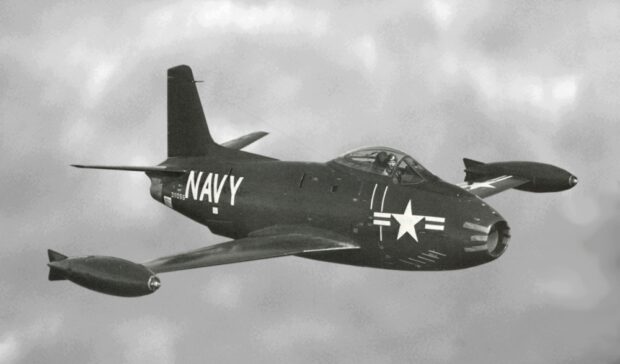The F-86 Sabre is rightly celebrated as one of the finest products of the US aviation industry. The story of the gamble that gave it swept wings is legendary. But North American produced another aircraft before the Sabre.
In fact, without it, the US Army Air Force would not have been convinced to commission the XP-86 in the first place. That aircraft was the Navy’y FJ-1 Fury. Where the Sabre is a legend, its older cousin’s existence has been brushed under the carpet for seventy years.
The North American FJ-1 Fury was an early turbojet-powered carrier-capable fighter aircraft used by the United States Navy (USN). Developed by North American Aviation (NAA) starting in 1945, it became the first jet aircraft in USN service to serve at sea under operational conditions. The FJ-1 was an early transitional jet of limited success which carried over similar tail surfaces, wing, and canopy derived from the piston-engined P-51D Mustang.
The evolution of the design to incorporate swept wings would become the basis for the land-based XP-86 prototype – itself originally designed with a very similar straight-wing planform to the FJ-1 airframe – of the United States Air Force’s enormously influential F-86 Sabre, which in turn formed the basis for the Navy’s carrier-based North American FJ-2/-3 Fury.
Design and development
In late 1944, the USN sought proposals for a follow-on aircraft to supplement its first jet fighter, the McDonnell XFD-1 Phantom; three competing proposals from NAA, McDonnell Aircraft Corporation and Vought were selected. The NAA NA-134 was ordered on 1 January 1945 as the XFJ-1 and would be developed in parallel with the Vought F6U Pirate (the competing McDonnell proposal would eventually evolve into the McDonnell F2H Banshee).
The XFJ-1 was a straight-wing, tricycle gear fighter with a single General Electric J35 turbojet fed by an intake passing through the fuselage; to avoid bifurcating the intake and thus increasing drag, the cockpit was placed entirely above the intake duct, giving the aircraft a squat appearance. It was armed with six .50 BMG machine guns mounted next to the air intake, making it the last aircraft ordered by the USN to use .50 BMG guns as its primary armament.
The wing, empennage, and canopy strongly resembled that of the piston-engined P-51D Mustang, North American Aviation’s highly successful World War II fighter, enclosing a relocated cockpit accommodation further forward in relation to the Mustang’s design, to ensure good forward pilot visibility for carrier operations.
Photo: US Navy FJ-1
Sources: Wikipedia; YouTube

